HR Project Report: HRM Issues in IHis Company Analysis
VerifiedAdded on 2021/02/19
|23
|8054
|262
Report
AI Summary
This HR project report delves into the human resource management practices of IHis, a technology agency in the public health sector. The report examines various motivation theories, including Maslow's hierarchy of needs and McGregor's Theory X and Y, and their application within the organization. It analyzes organizational control and reward systems, differentiating between intrinsic and extrinsic rewards, and considers the importance of personality types and organizational culture. The report also explores organizational change, the impact of culture on employee performance, and reflects on the experiential learning derived from the study of IHis. It emphasizes the role of HRM in attracting talent, enhancing employee competencies, and improving overall organizational performance. The report concludes with a reflection on the importance of organizational culture and the challenges of managing human resources in a technology-driven environment.
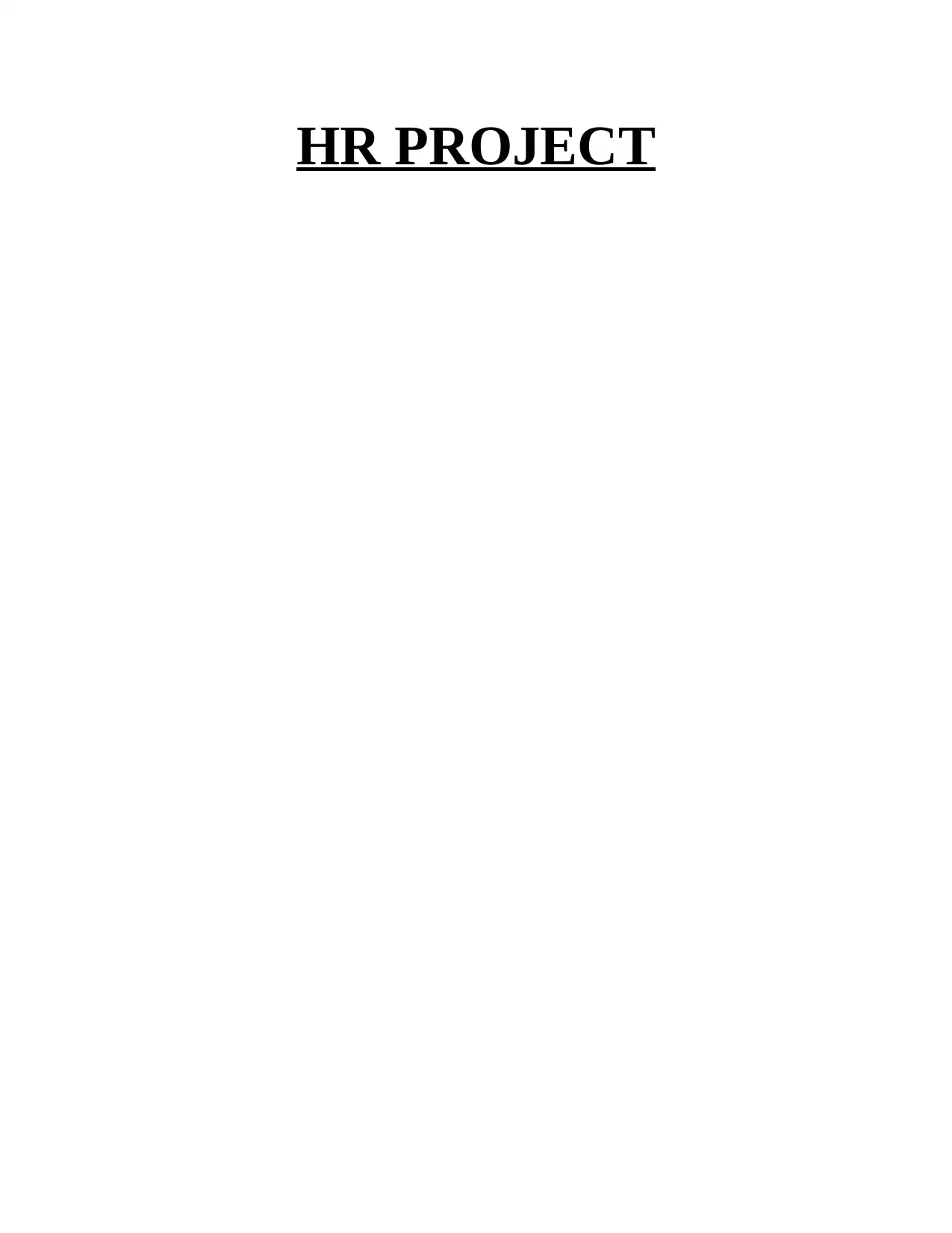
HR PROJECT
Paraphrase This Document
Need a fresh take? Get an instant paraphrase of this document with our AI Paraphraser
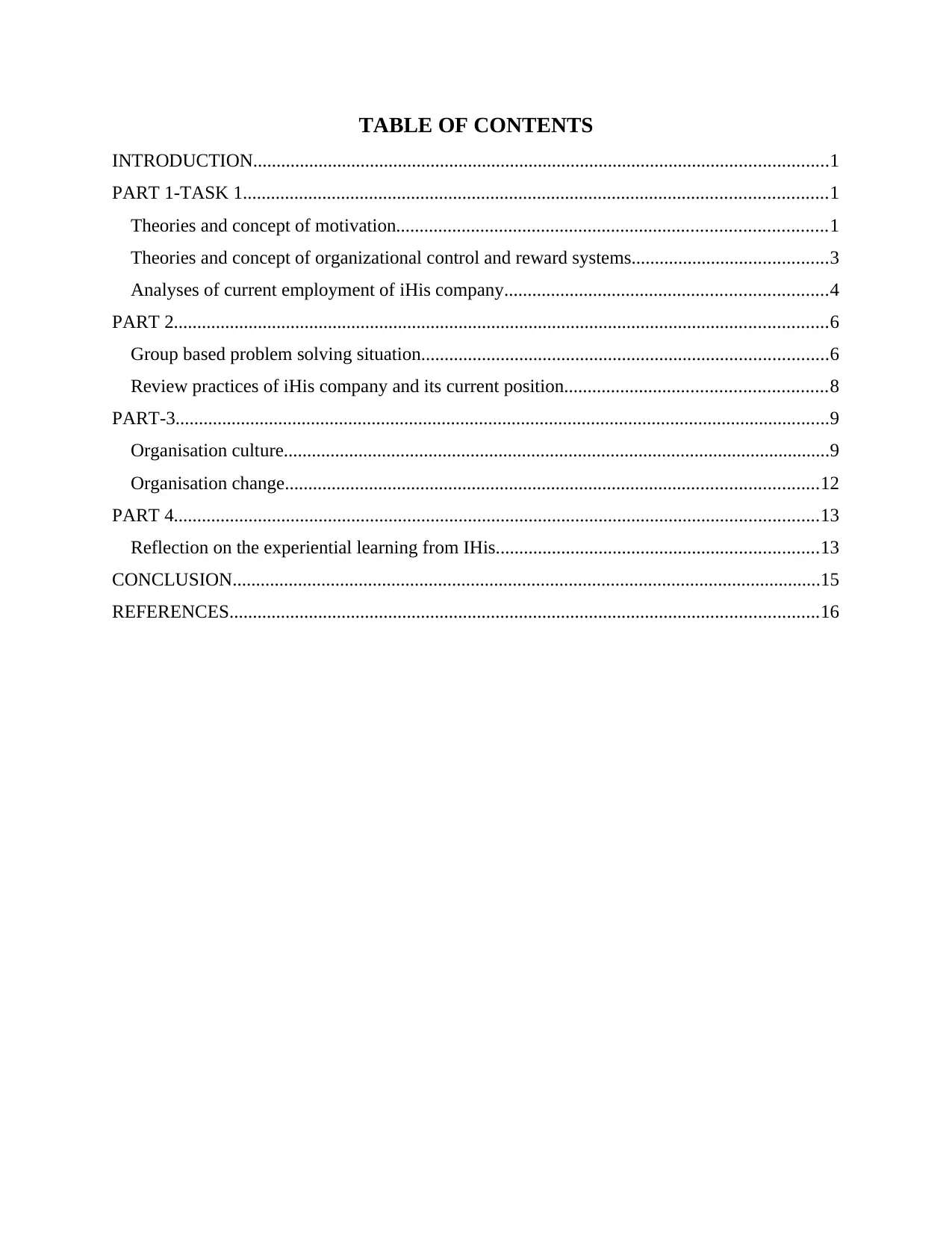
TABLE OF CONTENTS
INTRODUCTION...........................................................................................................................1
PART 1-TASK 1.............................................................................................................................1
Theories and concept of motivation............................................................................................1
Theories and concept of organizational control and reward systems..........................................3
Analyses of current employment of iHis company.....................................................................4
PART 2............................................................................................................................................6
Group based problem solving situation.......................................................................................6
Review practices of iHis company and its current position........................................................8
PART-3............................................................................................................................................9
Organisation culture.....................................................................................................................9
Organisation change..................................................................................................................12
PART 4..........................................................................................................................................13
Reflection on the experiential learning from IHis.....................................................................13
CONCLUSION..............................................................................................................................15
REFERENCES..............................................................................................................................16
INTRODUCTION...........................................................................................................................1
PART 1-TASK 1.............................................................................................................................1
Theories and concept of motivation............................................................................................1
Theories and concept of organizational control and reward systems..........................................3
Analyses of current employment of iHis company.....................................................................4
PART 2............................................................................................................................................6
Group based problem solving situation.......................................................................................6
Review practices of iHis company and its current position........................................................8
PART-3............................................................................................................................................9
Organisation culture.....................................................................................................................9
Organisation change..................................................................................................................12
PART 4..........................................................................................................................................13
Reflection on the experiential learning from IHis.....................................................................13
CONCLUSION..............................................................................................................................15
REFERENCES..............................................................................................................................16
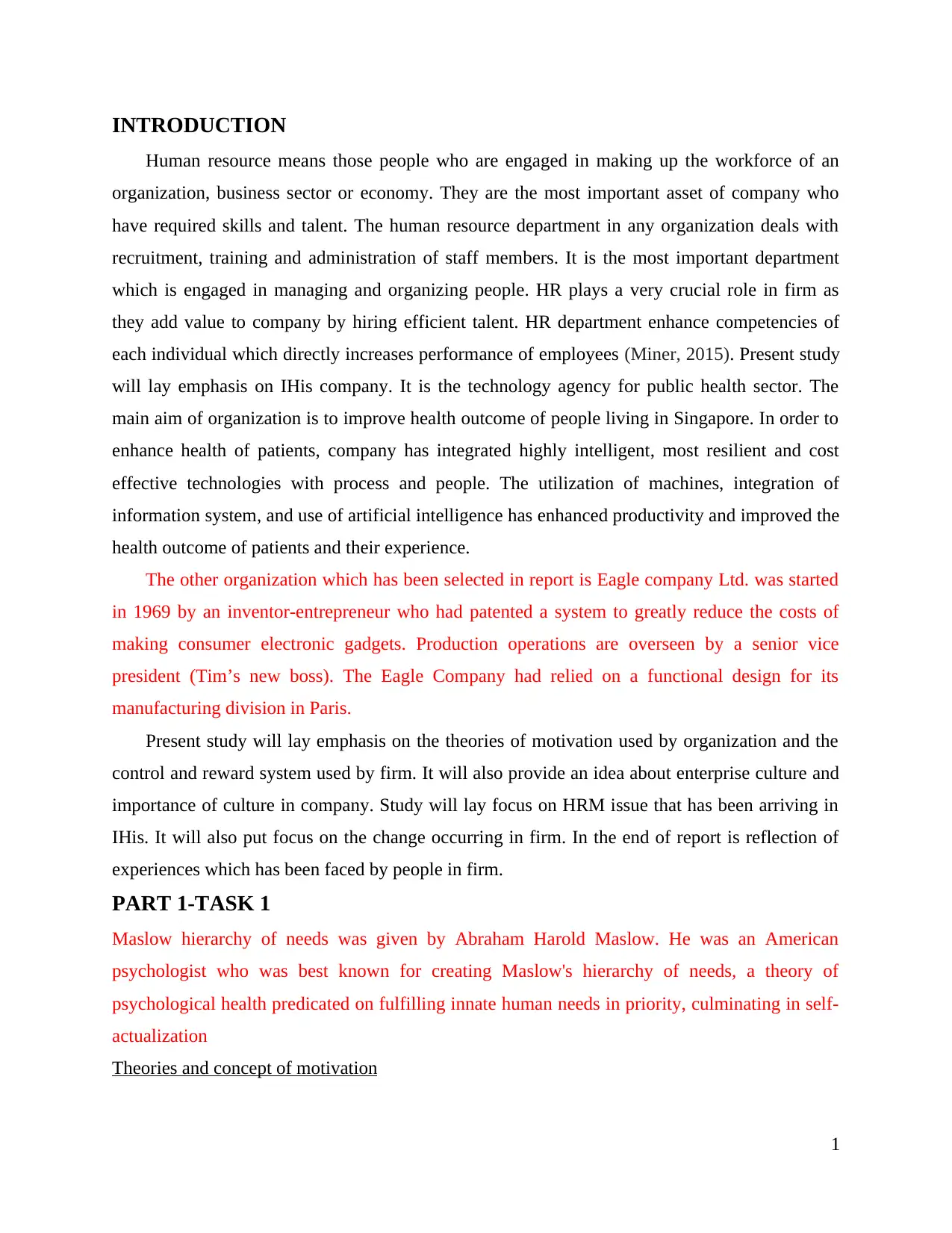
INTRODUCTION
Human resource means those people who are engaged in making up the workforce of an
organization, business sector or economy. They are the most important asset of company who
have required skills and talent. The human resource department in any organization deals with
recruitment, training and administration of staff members. It is the most important department
which is engaged in managing and organizing people. HR plays a very crucial role in firm as
they add value to company by hiring efficient talent. HR department enhance competencies of
each individual which directly increases performance of employees (Miner, 2015). Present study
will lay emphasis on IHis company. It is the technology agency for public health sector. The
main aim of organization is to improve health outcome of people living in Singapore. In order to
enhance health of patients, company has integrated highly intelligent, most resilient and cost
effective technologies with process and people. The utilization of machines, integration of
information system, and use of artificial intelligence has enhanced productivity and improved the
health outcome of patients and their experience.
The other organization which has been selected in report is Eagle company Ltd. was started
in 1969 by an inventor-entrepreneur who had patented a system to greatly reduce the costs of
making consumer electronic gadgets. Production operations are overseen by a senior vice
president (Tim’s new boss). The Eagle Company had relied on a functional design for its
manufacturing division in Paris.
Present study will lay emphasis on the theories of motivation used by organization and the
control and reward system used by firm. It will also provide an idea about enterprise culture and
importance of culture in company. Study will lay focus on HRM issue that has been arriving in
IHis. It will also put focus on the change occurring in firm. In the end of report is reflection of
experiences which has been faced by people in firm.
PART 1-TASK 1
Maslow hierarchy of needs was given by Abraham Harold Maslow. He was an American
psychologist who was best known for creating Maslow's hierarchy of needs, a theory of
psychological health predicated on fulfilling innate human needs in priority, culminating in self-
actualization
Theories and concept of motivation
1
Human resource means those people who are engaged in making up the workforce of an
organization, business sector or economy. They are the most important asset of company who
have required skills and talent. The human resource department in any organization deals with
recruitment, training and administration of staff members. It is the most important department
which is engaged in managing and organizing people. HR plays a very crucial role in firm as
they add value to company by hiring efficient talent. HR department enhance competencies of
each individual which directly increases performance of employees (Miner, 2015). Present study
will lay emphasis on IHis company. It is the technology agency for public health sector. The
main aim of organization is to improve health outcome of people living in Singapore. In order to
enhance health of patients, company has integrated highly intelligent, most resilient and cost
effective technologies with process and people. The utilization of machines, integration of
information system, and use of artificial intelligence has enhanced productivity and improved the
health outcome of patients and their experience.
The other organization which has been selected in report is Eagle company Ltd. was started
in 1969 by an inventor-entrepreneur who had patented a system to greatly reduce the costs of
making consumer electronic gadgets. Production operations are overseen by a senior vice
president (Tim’s new boss). The Eagle Company had relied on a functional design for its
manufacturing division in Paris.
Present study will lay emphasis on the theories of motivation used by organization and the
control and reward system used by firm. It will also provide an idea about enterprise culture and
importance of culture in company. Study will lay focus on HRM issue that has been arriving in
IHis. It will also put focus on the change occurring in firm. In the end of report is reflection of
experiences which has been faced by people in firm.
PART 1-TASK 1
Maslow hierarchy of needs was given by Abraham Harold Maslow. He was an American
psychologist who was best known for creating Maslow's hierarchy of needs, a theory of
psychological health predicated on fulfilling innate human needs in priority, culminating in self-
actualization
Theories and concept of motivation
1
⊘ This is a preview!⊘
Do you want full access?
Subscribe today to unlock all pages.

Trusted by 1+ million students worldwide
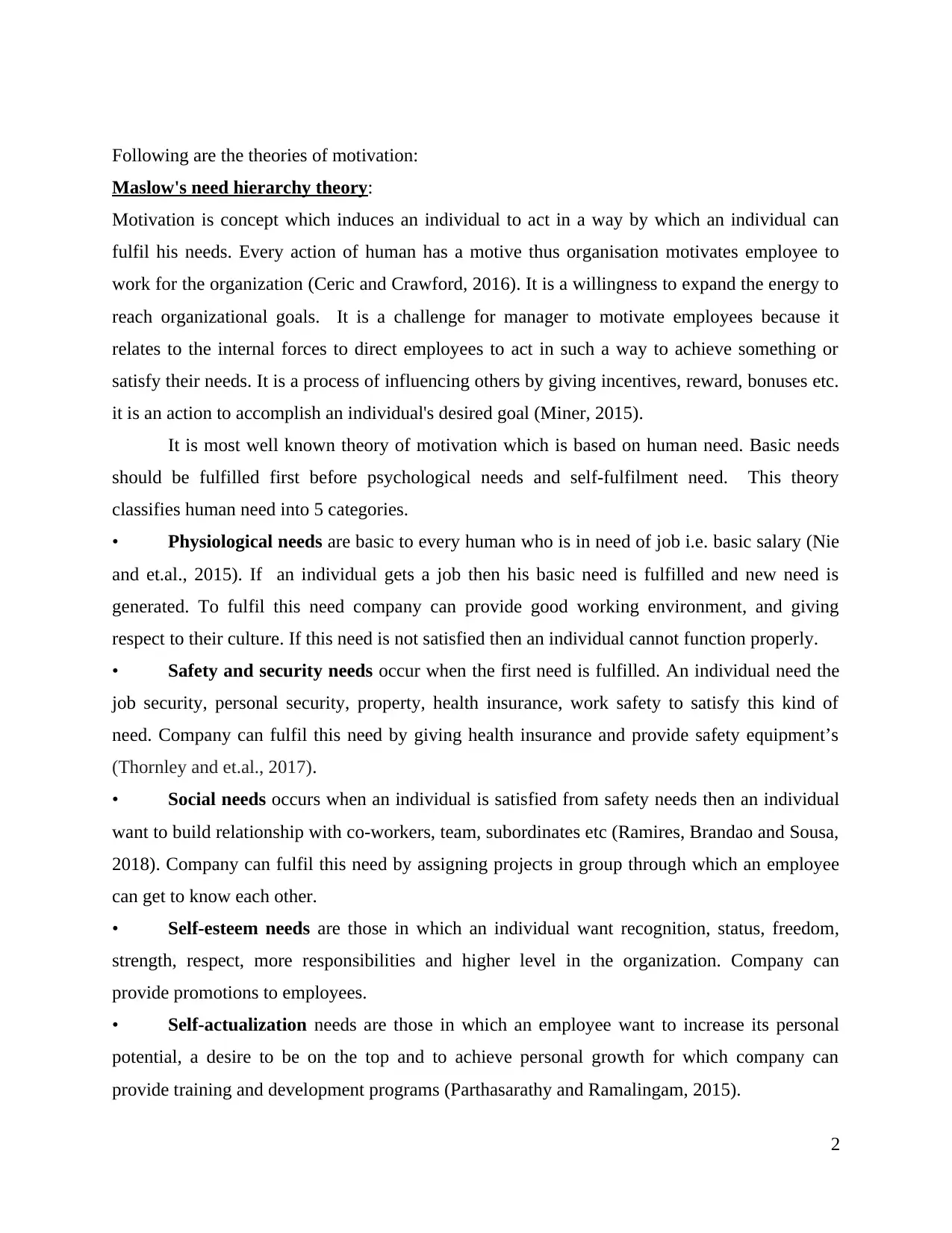
Following are the theories of motivation:
Maslow's need hierarchy theory:
Motivation is concept which induces an individual to act in a way by which an individual can
fulfil his needs. Every action of human has a motive thus organisation motivates employee to
work for the organization (Ceric and Crawford, 2016). It is a willingness to expand the energy to
reach organizational goals. It is a challenge for manager to motivate employees because it
relates to the internal forces to direct employees to act in such a way to achieve something or
satisfy their needs. It is a process of influencing others by giving incentives, reward, bonuses etc.
it is an action to accomplish an individual's desired goal (Miner, 2015).
It is most well known theory of motivation which is based on human need. Basic needs
should be fulfilled first before psychological needs and self-fulfilment need. This theory
classifies human need into 5 categories.
• Physiological needs are basic to every human who is in need of job i.e. basic salary (Nie
and et.al., 2015). If an individual gets a job then his basic need is fulfilled and new need is
generated. To fulfil this need company can provide good working environment, and giving
respect to their culture. If this need is not satisfied then an individual cannot function properly.
• Safety and security needs occur when the first need is fulfilled. An individual need the
job security, personal security, property, health insurance, work safety to satisfy this kind of
need. Company can fulfil this need by giving health insurance and provide safety equipment’s
(Thornley and et.al., 2017).
• Social needs occurs when an individual is satisfied from safety needs then an individual
want to build relationship with co-workers, team, subordinates etc (Ramires, Brandao and Sousa,
2018). Company can fulfil this need by assigning projects in group through which an employee
can get to know each other.
• Self-esteem needs are those in which an individual want recognition, status, freedom,
strength, respect, more responsibilities and higher level in the organization. Company can
provide promotions to employees.
• Self-actualization needs are those in which an employee want to increase its personal
potential, a desire to be on the top and to achieve personal growth for which company can
provide training and development programs (Parthasarathy and Ramalingam, 2015).
2
Maslow's need hierarchy theory:
Motivation is concept which induces an individual to act in a way by which an individual can
fulfil his needs. Every action of human has a motive thus organisation motivates employee to
work for the organization (Ceric and Crawford, 2016). It is a willingness to expand the energy to
reach organizational goals. It is a challenge for manager to motivate employees because it
relates to the internal forces to direct employees to act in such a way to achieve something or
satisfy their needs. It is a process of influencing others by giving incentives, reward, bonuses etc.
it is an action to accomplish an individual's desired goal (Miner, 2015).
It is most well known theory of motivation which is based on human need. Basic needs
should be fulfilled first before psychological needs and self-fulfilment need. This theory
classifies human need into 5 categories.
• Physiological needs are basic to every human who is in need of job i.e. basic salary (Nie
and et.al., 2015). If an individual gets a job then his basic need is fulfilled and new need is
generated. To fulfil this need company can provide good working environment, and giving
respect to their culture. If this need is not satisfied then an individual cannot function properly.
• Safety and security needs occur when the first need is fulfilled. An individual need the
job security, personal security, property, health insurance, work safety to satisfy this kind of
need. Company can fulfil this need by giving health insurance and provide safety equipment’s
(Thornley and et.al., 2017).
• Social needs occurs when an individual is satisfied from safety needs then an individual
want to build relationship with co-workers, team, subordinates etc (Ramires, Brandao and Sousa,
2018). Company can fulfil this need by assigning projects in group through which an employee
can get to know each other.
• Self-esteem needs are those in which an individual want recognition, status, freedom,
strength, respect, more responsibilities and higher level in the organization. Company can
provide promotions to employees.
• Self-actualization needs are those in which an employee want to increase its personal
potential, a desire to be on the top and to achieve personal growth for which company can
provide training and development programs (Parthasarathy and Ramalingam, 2015).
2
Paraphrase This Document
Need a fresh take? Get an instant paraphrase of this document with our AI Paraphraser
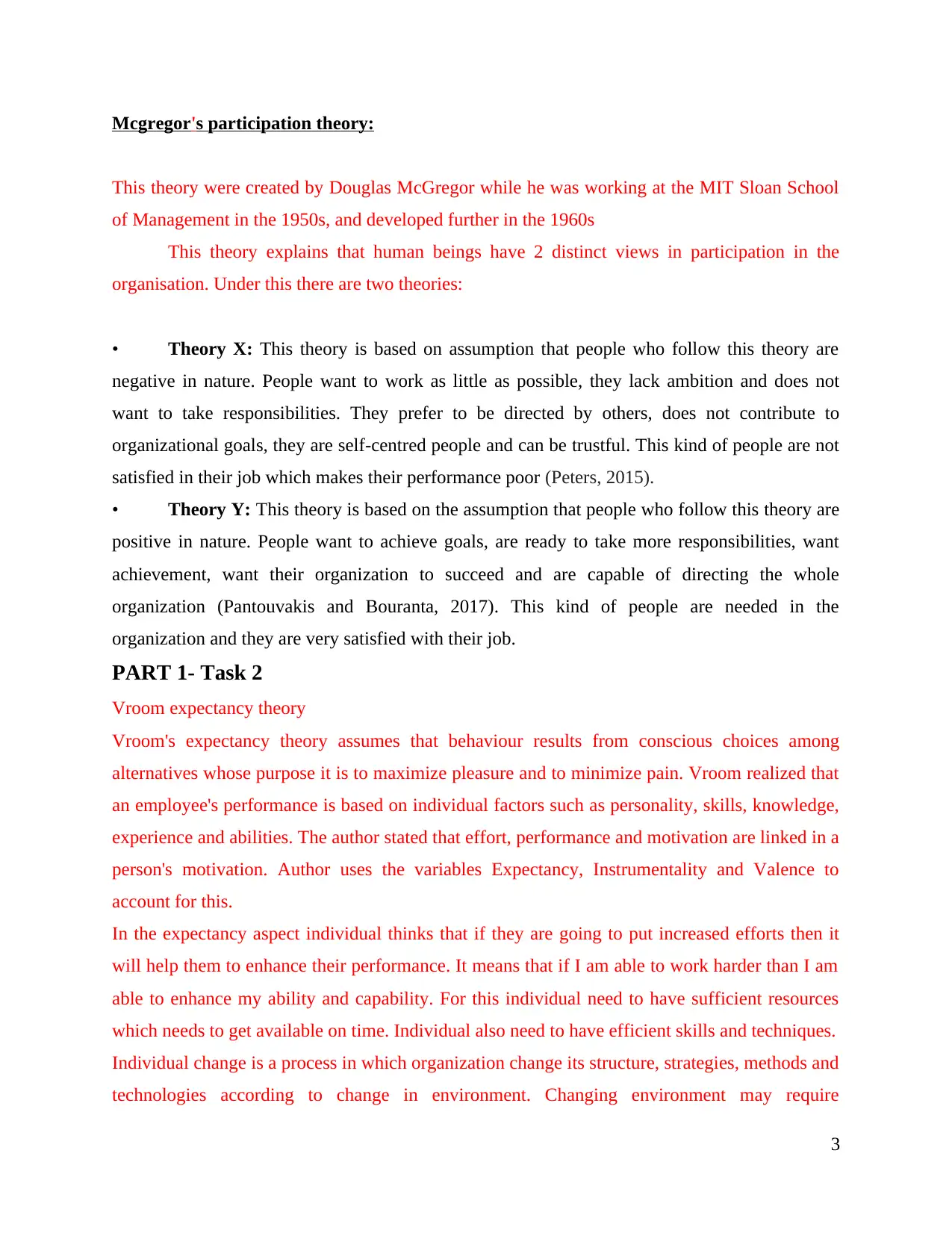
Mcgregor's participation theory:
This theory were created by Douglas McGregor while he was working at the MIT Sloan School
of Management in the 1950s, and developed further in the 1960s
This theory explains that human beings have 2 distinct views in participation in the
organisation. Under this there are two theories:
• Theory X: This theory is based on assumption that people who follow this theory are
negative in nature. People want to work as little as possible, they lack ambition and does not
want to take responsibilities. They prefer to be directed by others, does not contribute to
organizational goals, they are self-centred people and can be trustful. This kind of people are not
satisfied in their job which makes their performance poor (Peters, 2015).
• Theory Y: This theory is based on the assumption that people who follow this theory are
positive in nature. People want to achieve goals, are ready to take more responsibilities, want
achievement, want their organization to succeed and are capable of directing the whole
organization (Pantouvakis and Bouranta, 2017). This kind of people are needed in the
organization and they are very satisfied with their job.
PART 1- Task 2
Vroom expectancy theory
Vroom's expectancy theory assumes that behaviour results from conscious choices among
alternatives whose purpose it is to maximize pleasure and to minimize pain. Vroom realized that
an employee's performance is based on individual factors such as personality, skills, knowledge,
experience and abilities. The author stated that effort, performance and motivation are linked in a
person's motivation. Author uses the variables Expectancy, Instrumentality and Valence to
account for this.
In the expectancy aspect individual thinks that if they are going to put increased efforts then it
will help them to enhance their performance. It means that if I am able to work harder than I am
able to enhance my ability and capability. For this individual need to have sufficient resources
which needs to get available on time. Individual also need to have efficient skills and techniques.
Individual change is a process in which organization change its structure, strategies, methods and
technologies according to change in environment. Changing environment may require
3
This theory were created by Douglas McGregor while he was working at the MIT Sloan School
of Management in the 1950s, and developed further in the 1960s
This theory explains that human beings have 2 distinct views in participation in the
organisation. Under this there are two theories:
• Theory X: This theory is based on assumption that people who follow this theory are
negative in nature. People want to work as little as possible, they lack ambition and does not
want to take responsibilities. They prefer to be directed by others, does not contribute to
organizational goals, they are self-centred people and can be trustful. This kind of people are not
satisfied in their job which makes their performance poor (Peters, 2015).
• Theory Y: This theory is based on the assumption that people who follow this theory are
positive in nature. People want to achieve goals, are ready to take more responsibilities, want
achievement, want their organization to succeed and are capable of directing the whole
organization (Pantouvakis and Bouranta, 2017). This kind of people are needed in the
organization and they are very satisfied with their job.
PART 1- Task 2
Vroom expectancy theory
Vroom's expectancy theory assumes that behaviour results from conscious choices among
alternatives whose purpose it is to maximize pleasure and to minimize pain. Vroom realized that
an employee's performance is based on individual factors such as personality, skills, knowledge,
experience and abilities. The author stated that effort, performance and motivation are linked in a
person's motivation. Author uses the variables Expectancy, Instrumentality and Valence to
account for this.
In the expectancy aspect individual thinks that if they are going to put increased efforts then it
will help them to enhance their performance. It means that if I am able to work harder than I am
able to enhance my ability and capability. For this individual need to have sufficient resources
which needs to get available on time. Individual also need to have efficient skills and techniques.
Individual change is a process in which organization change its structure, strategies, methods and
technologies according to change in environment. Changing environment may require
3
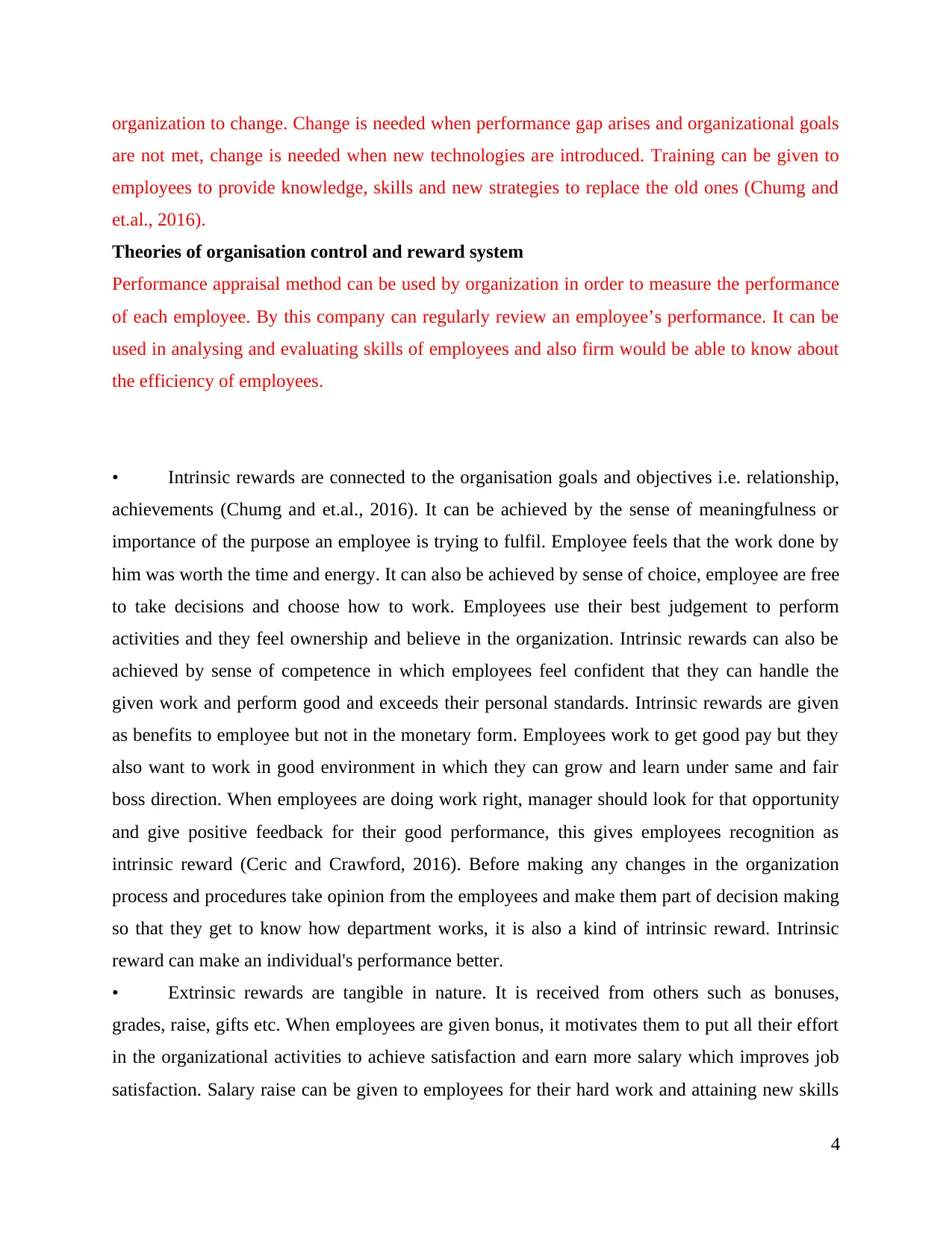
organization to change. Change is needed when performance gap arises and organizational goals
are not met, change is needed when new technologies are introduced. Training can be given to
employees to provide knowledge, skills and new strategies to replace the old ones (Chumg and
et.al., 2016).
Theories of organisation control and reward system
Performance appraisal method can be used by organization in order to measure the performance
of each employee. By this company can regularly review an employee’s performance. It can be
used in analysing and evaluating skills of employees and also firm would be able to know about
the efficiency of employees.
• Intrinsic rewards are connected to the organisation goals and objectives i.e. relationship,
achievements (Chumg and et.al., 2016). It can be achieved by the sense of meaningfulness or
importance of the purpose an employee is trying to fulfil. Employee feels that the work done by
him was worth the time and energy. It can also be achieved by sense of choice, employee are free
to take decisions and choose how to work. Employees use their best judgement to perform
activities and they feel ownership and believe in the organization. Intrinsic rewards can also be
achieved by sense of competence in which employees feel confident that they can handle the
given work and perform good and exceeds their personal standards. Intrinsic rewards are given
as benefits to employee but not in the monetary form. Employees work to get good pay but they
also want to work in good environment in which they can grow and learn under same and fair
boss direction. When employees are doing work right, manager should look for that opportunity
and give positive feedback for their good performance, this gives employees recognition as
intrinsic reward (Ceric and Crawford, 2016). Before making any changes in the organization
process and procedures take opinion from the employees and make them part of decision making
so that they get to know how department works, it is also a kind of intrinsic reward. Intrinsic
reward can make an individual's performance better.
• Extrinsic rewards are tangible in nature. It is received from others such as bonuses,
grades, raise, gifts etc. When employees are given bonus, it motivates them to put all their effort
in the organizational activities to achieve satisfaction and earn more salary which improves job
satisfaction. Salary raise can be given to employees for their hard work and attaining new skills
4
are not met, change is needed when new technologies are introduced. Training can be given to
employees to provide knowledge, skills and new strategies to replace the old ones (Chumg and
et.al., 2016).
Theories of organisation control and reward system
Performance appraisal method can be used by organization in order to measure the performance
of each employee. By this company can regularly review an employee’s performance. It can be
used in analysing and evaluating skills of employees and also firm would be able to know about
the efficiency of employees.
• Intrinsic rewards are connected to the organisation goals and objectives i.e. relationship,
achievements (Chumg and et.al., 2016). It can be achieved by the sense of meaningfulness or
importance of the purpose an employee is trying to fulfil. Employee feels that the work done by
him was worth the time and energy. It can also be achieved by sense of choice, employee are free
to take decisions and choose how to work. Employees use their best judgement to perform
activities and they feel ownership and believe in the organization. Intrinsic rewards can also be
achieved by sense of competence in which employees feel confident that they can handle the
given work and perform good and exceeds their personal standards. Intrinsic rewards are given
as benefits to employee but not in the monetary form. Employees work to get good pay but they
also want to work in good environment in which they can grow and learn under same and fair
boss direction. When employees are doing work right, manager should look for that opportunity
and give positive feedback for their good performance, this gives employees recognition as
intrinsic reward (Ceric and Crawford, 2016). Before making any changes in the organization
process and procedures take opinion from the employees and make them part of decision making
so that they get to know how department works, it is also a kind of intrinsic reward. Intrinsic
reward can make an individual's performance better.
• Extrinsic rewards are tangible in nature. It is received from others such as bonuses,
grades, raise, gifts etc. When employees are given bonus, it motivates them to put all their effort
in the organizational activities to achieve satisfaction and earn more salary which improves job
satisfaction. Salary raise can be given to employees for their hard work and attaining new skills
4
⊘ This is a preview!⊘
Do you want full access?
Subscribe today to unlock all pages.

Trusted by 1+ million students worldwide
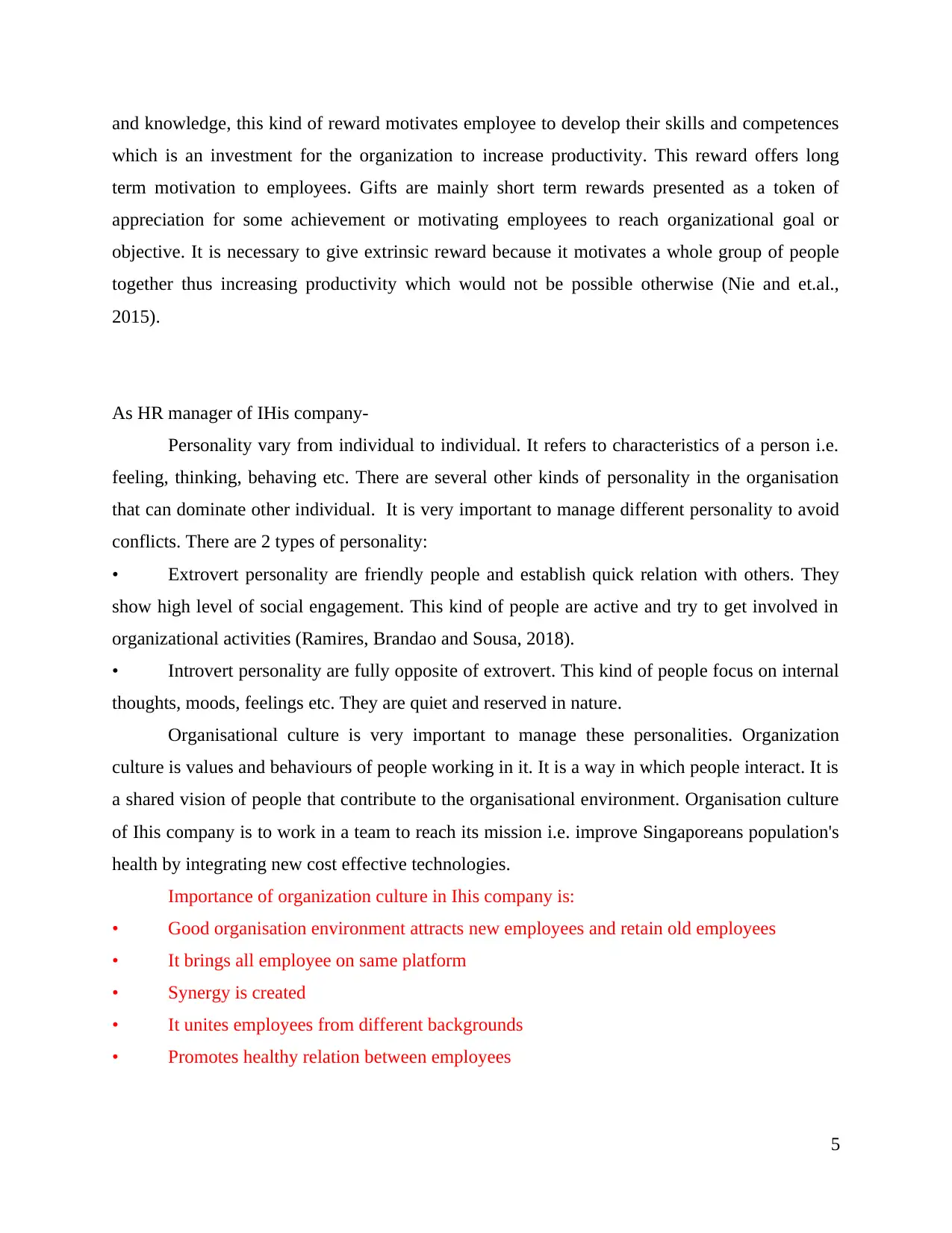
and knowledge, this kind of reward motivates employee to develop their skills and competences
which is an investment for the organization to increase productivity. This reward offers long
term motivation to employees. Gifts are mainly short term rewards presented as a token of
appreciation for some achievement or motivating employees to reach organizational goal or
objective. It is necessary to give extrinsic reward because it motivates a whole group of people
together thus increasing productivity which would not be possible otherwise (Nie and et.al.,
2015).
As HR manager of IHis company-
Personality vary from individual to individual. It refers to characteristics of a person i.e.
feeling, thinking, behaving etc. There are several other kinds of personality in the organisation
that can dominate other individual. It is very important to manage different personality to avoid
conflicts. There are 2 types of personality:
• Extrovert personality are friendly people and establish quick relation with others. They
show high level of social engagement. This kind of people are active and try to get involved in
organizational activities (Ramires, Brandao and Sousa, 2018).
• Introvert personality are fully opposite of extrovert. This kind of people focus on internal
thoughts, moods, feelings etc. They are quiet and reserved in nature.
Organisational culture is very important to manage these personalities. Organization
culture is values and behaviours of people working in it. It is a way in which people interact. It is
a shared vision of people that contribute to the organisational environment. Organisation culture
of Ihis company is to work in a team to reach its mission i.e. improve Singaporeans population's
health by integrating new cost effective technologies.
Importance of organization culture in Ihis company is:
• Good organisation environment attracts new employees and retain old employees
• It brings all employee on same platform
• Synergy is created
• It unites employees from different backgrounds
• Promotes healthy relation between employees
5
which is an investment for the organization to increase productivity. This reward offers long
term motivation to employees. Gifts are mainly short term rewards presented as a token of
appreciation for some achievement or motivating employees to reach organizational goal or
objective. It is necessary to give extrinsic reward because it motivates a whole group of people
together thus increasing productivity which would not be possible otherwise (Nie and et.al.,
2015).
As HR manager of IHis company-
Personality vary from individual to individual. It refers to characteristics of a person i.e.
feeling, thinking, behaving etc. There are several other kinds of personality in the organisation
that can dominate other individual. It is very important to manage different personality to avoid
conflicts. There are 2 types of personality:
• Extrovert personality are friendly people and establish quick relation with others. They
show high level of social engagement. This kind of people are active and try to get involved in
organizational activities (Ramires, Brandao and Sousa, 2018).
• Introvert personality are fully opposite of extrovert. This kind of people focus on internal
thoughts, moods, feelings etc. They are quiet and reserved in nature.
Organisational culture is very important to manage these personalities. Organization
culture is values and behaviours of people working in it. It is a way in which people interact. It is
a shared vision of people that contribute to the organisational environment. Organisation culture
of Ihis company is to work in a team to reach its mission i.e. improve Singaporeans population's
health by integrating new cost effective technologies.
Importance of organization culture in Ihis company is:
• Good organisation environment attracts new employees and retain old employees
• It brings all employee on same platform
• Synergy is created
• It unites employees from different backgrounds
• Promotes healthy relation between employees
5
Paraphrase This Document
Need a fresh take? Get an instant paraphrase of this document with our AI Paraphraser
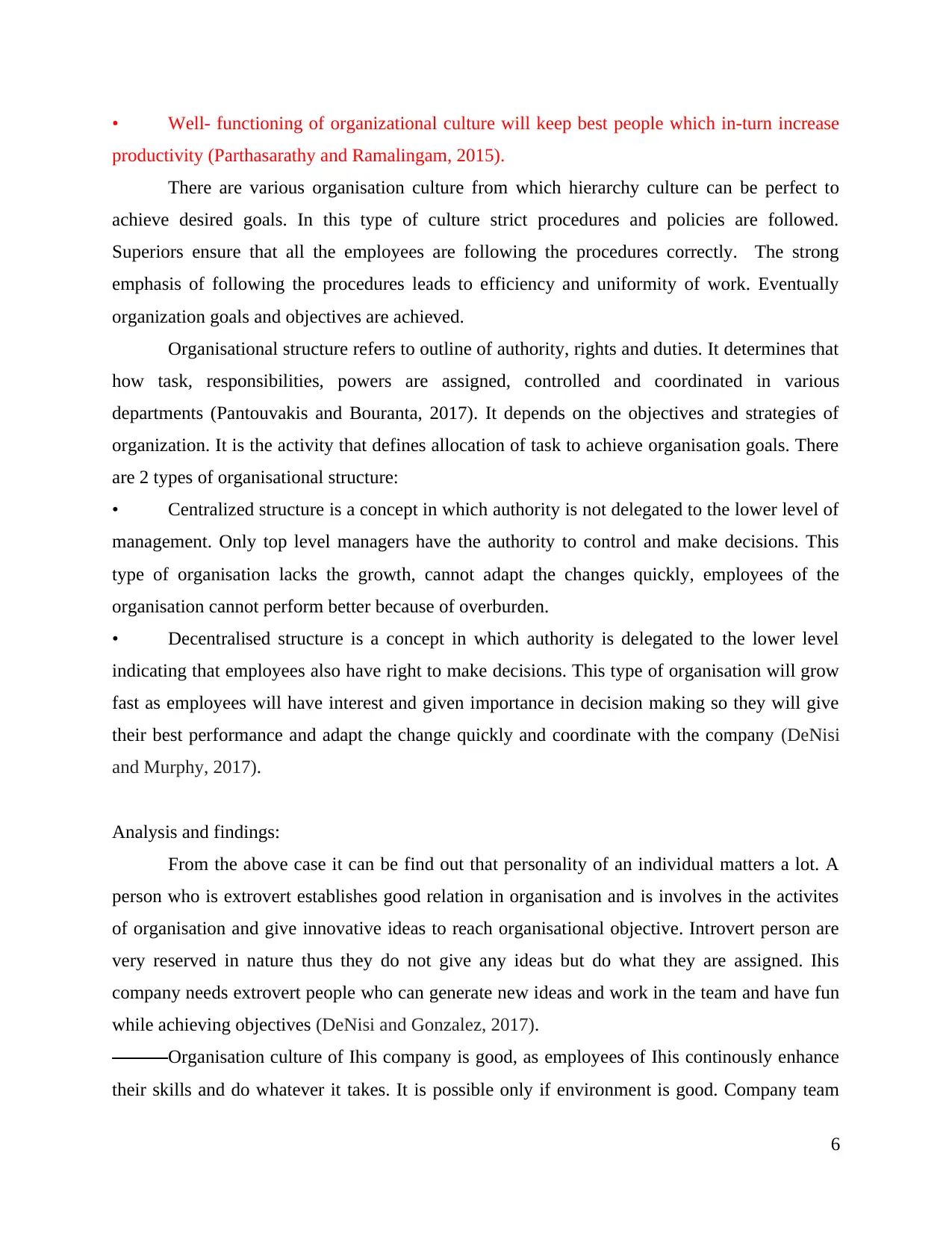
• Well- functioning of organizational culture will keep best people which in-turn increase
productivity (Parthasarathy and Ramalingam, 2015).
There are various organisation culture from which hierarchy culture can be perfect to
achieve desired goals. In this type of culture strict procedures and policies are followed.
Superiors ensure that all the employees are following the procedures correctly. The strong
emphasis of following the procedures leads to efficiency and uniformity of work. Eventually
organization goals and objectives are achieved.
Organisational structure refers to outline of authority, rights and duties. It determines that
how task, responsibilities, powers are assigned, controlled and coordinated in various
departments (Pantouvakis and Bouranta, 2017). It depends on the objectives and strategies of
organization. It is the activity that defines allocation of task to achieve organisation goals. There
are 2 types of organisational structure:
• Centralized structure is a concept in which authority is not delegated to the lower level of
management. Only top level managers have the authority to control and make decisions. This
type of organisation lacks the growth, cannot adapt the changes quickly, employees of the
organisation cannot perform better because of overburden.
• Decentralised structure is a concept in which authority is delegated to the lower level
indicating that employees also have right to make decisions. This type of organisation will grow
fast as employees will have interest and given importance in decision making so they will give
their best performance and adapt the change quickly and coordinate with the company (DeNisi
and Murphy, 2017).
Analysis and findings:
From the above case it can be find out that personality of an individual matters a lot. A
person who is extrovert establishes good relation in organisation and is involves in the activites
of organisation and give innovative ideas to reach organisational objective. Introvert person are
very reserved in nature thus they do not give any ideas but do what they are assigned. Ihis
company needs extrovert people who can generate new ideas and work in the team and have fun
while achieving objectives (DeNisi and Gonzalez, 2017).
Organisation culture of Ihis company is good, as employees of Ihis continously enhance
their skills and do whatever it takes. It is possible only if environment is good. Company team
6
productivity (Parthasarathy and Ramalingam, 2015).
There are various organisation culture from which hierarchy culture can be perfect to
achieve desired goals. In this type of culture strict procedures and policies are followed.
Superiors ensure that all the employees are following the procedures correctly. The strong
emphasis of following the procedures leads to efficiency and uniformity of work. Eventually
organization goals and objectives are achieved.
Organisational structure refers to outline of authority, rights and duties. It determines that
how task, responsibilities, powers are assigned, controlled and coordinated in various
departments (Pantouvakis and Bouranta, 2017). It depends on the objectives and strategies of
organization. It is the activity that defines allocation of task to achieve organisation goals. There
are 2 types of organisational structure:
• Centralized structure is a concept in which authority is not delegated to the lower level of
management. Only top level managers have the authority to control and make decisions. This
type of organisation lacks the growth, cannot adapt the changes quickly, employees of the
organisation cannot perform better because of overburden.
• Decentralised structure is a concept in which authority is delegated to the lower level
indicating that employees also have right to make decisions. This type of organisation will grow
fast as employees will have interest and given importance in decision making so they will give
their best performance and adapt the change quickly and coordinate with the company (DeNisi
and Murphy, 2017).
Analysis and findings:
From the above case it can be find out that personality of an individual matters a lot. A
person who is extrovert establishes good relation in organisation and is involves in the activites
of organisation and give innovative ideas to reach organisational objective. Introvert person are
very reserved in nature thus they do not give any ideas but do what they are assigned. Ihis
company needs extrovert people who can generate new ideas and work in the team and have fun
while achieving objectives (DeNisi and Gonzalez, 2017).
Organisation culture of Ihis company is good, as employees of Ihis continously enhance
their skills and do whatever it takes. It is possible only if environment is good. Company team
6
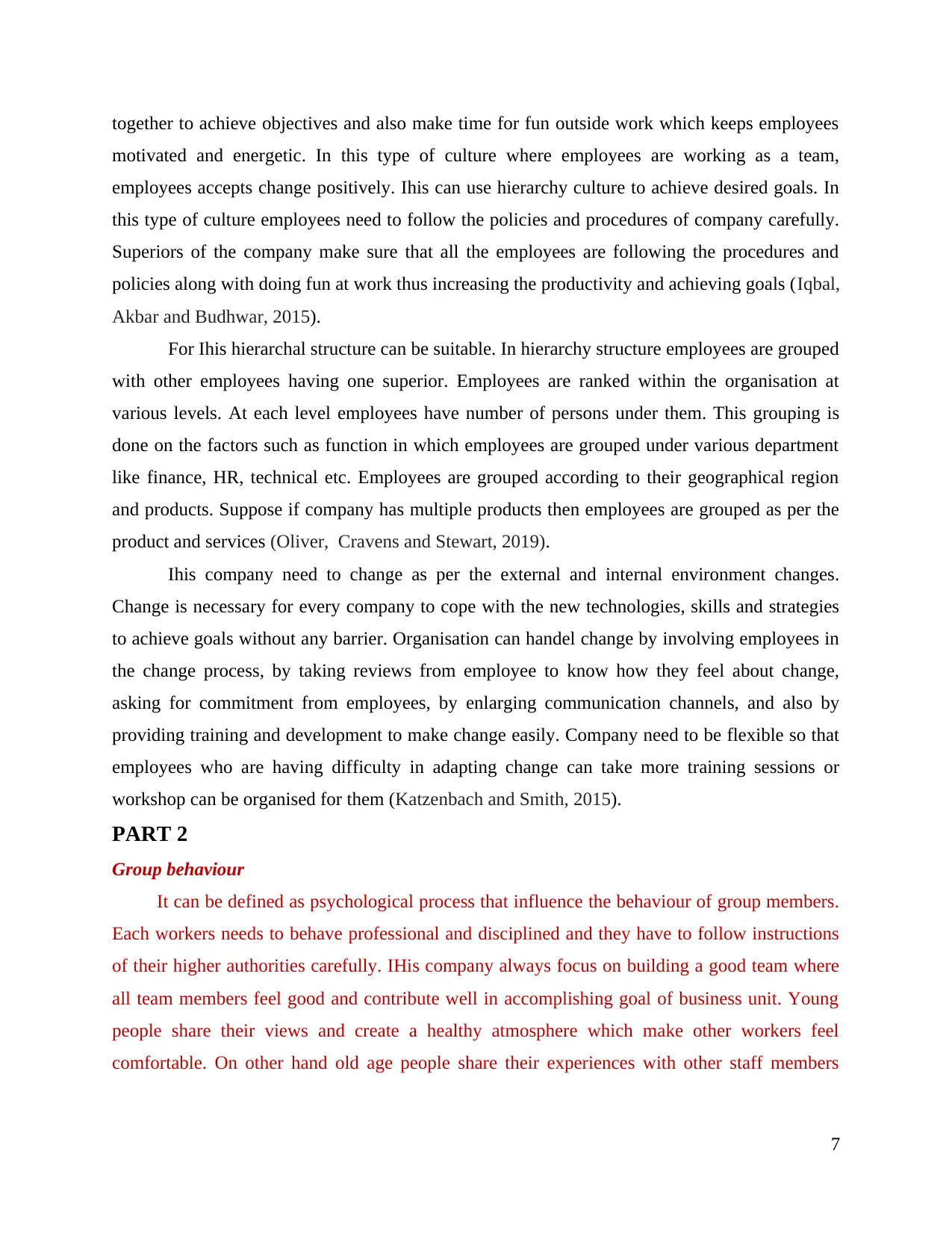
together to achieve objectives and also make time for fun outside work which keeps employees
motivated and energetic. In this type of culture where employees are working as a team,
employees accepts change positively. Ihis can use hierarchy culture to achieve desired goals. In
this type of culture employees need to follow the policies and procedures of company carefully.
Superiors of the company make sure that all the employees are following the procedures and
policies along with doing fun at work thus increasing the productivity and achieving goals (Iqbal,
Akbar and Budhwar, 2015).
For Ihis hierarchal structure can be suitable. In hierarchy structure employees are grouped
with other employees having one superior. Employees are ranked within the organisation at
various levels. At each level employees have number of persons under them. This grouping is
done on the factors such as function in which employees are grouped under various department
like finance, HR, technical etc. Employees are grouped according to their geographical region
and products. Suppose if company has multiple products then employees are grouped as per the
product and services (Oliver, Cravens and Stewart, 2019).
Ihis company need to change as per the external and internal environment changes.
Change is necessary for every company to cope with the new technologies, skills and strategies
to achieve goals without any barrier. Organisation can handel change by involving employees in
the change process, by taking reviews from employee to know how they feel about change,
asking for commitment from employees, by enlarging communication channels, and also by
providing training and development to make change easily. Company need to be flexible so that
employees who are having difficulty in adapting change can take more training sessions or
workshop can be organised for them (Katzenbach and Smith, 2015).
PART 2
Group behaviour
It can be defined as psychological process that influence the behaviour of group members.
Each workers needs to behave professional and disciplined and they have to follow instructions
of their higher authorities carefully. IHis company always focus on building a good team where
all team members feel good and contribute well in accomplishing goal of business unit. Young
people share their views and create a healthy atmosphere which make other workers feel
comfortable. On other hand old age people share their experiences with other staff members
7
motivated and energetic. In this type of culture where employees are working as a team,
employees accepts change positively. Ihis can use hierarchy culture to achieve desired goals. In
this type of culture employees need to follow the policies and procedures of company carefully.
Superiors of the company make sure that all the employees are following the procedures and
policies along with doing fun at work thus increasing the productivity and achieving goals (Iqbal,
Akbar and Budhwar, 2015).
For Ihis hierarchal structure can be suitable. In hierarchy structure employees are grouped
with other employees having one superior. Employees are ranked within the organisation at
various levels. At each level employees have number of persons under them. This grouping is
done on the factors such as function in which employees are grouped under various department
like finance, HR, technical etc. Employees are grouped according to their geographical region
and products. Suppose if company has multiple products then employees are grouped as per the
product and services (Oliver, Cravens and Stewart, 2019).
Ihis company need to change as per the external and internal environment changes.
Change is necessary for every company to cope with the new technologies, skills and strategies
to achieve goals without any barrier. Organisation can handel change by involving employees in
the change process, by taking reviews from employee to know how they feel about change,
asking for commitment from employees, by enlarging communication channels, and also by
providing training and development to make change easily. Company need to be flexible so that
employees who are having difficulty in adapting change can take more training sessions or
workshop can be organised for them (Katzenbach and Smith, 2015).
PART 2
Group behaviour
It can be defined as psychological process that influence the behaviour of group members.
Each workers needs to behave professional and disciplined and they have to follow instructions
of their higher authorities carefully. IHis company always focus on building a good team where
all team members feel good and contribute well in accomplishing goal of business unit. Young
people share their views and create a healthy atmosphere which make other workers feel
comfortable. On other hand old age people share their experiences with other staff members
7
⊘ This is a preview!⊘
Do you want full access?
Subscribe today to unlock all pages.

Trusted by 1+ million students worldwide
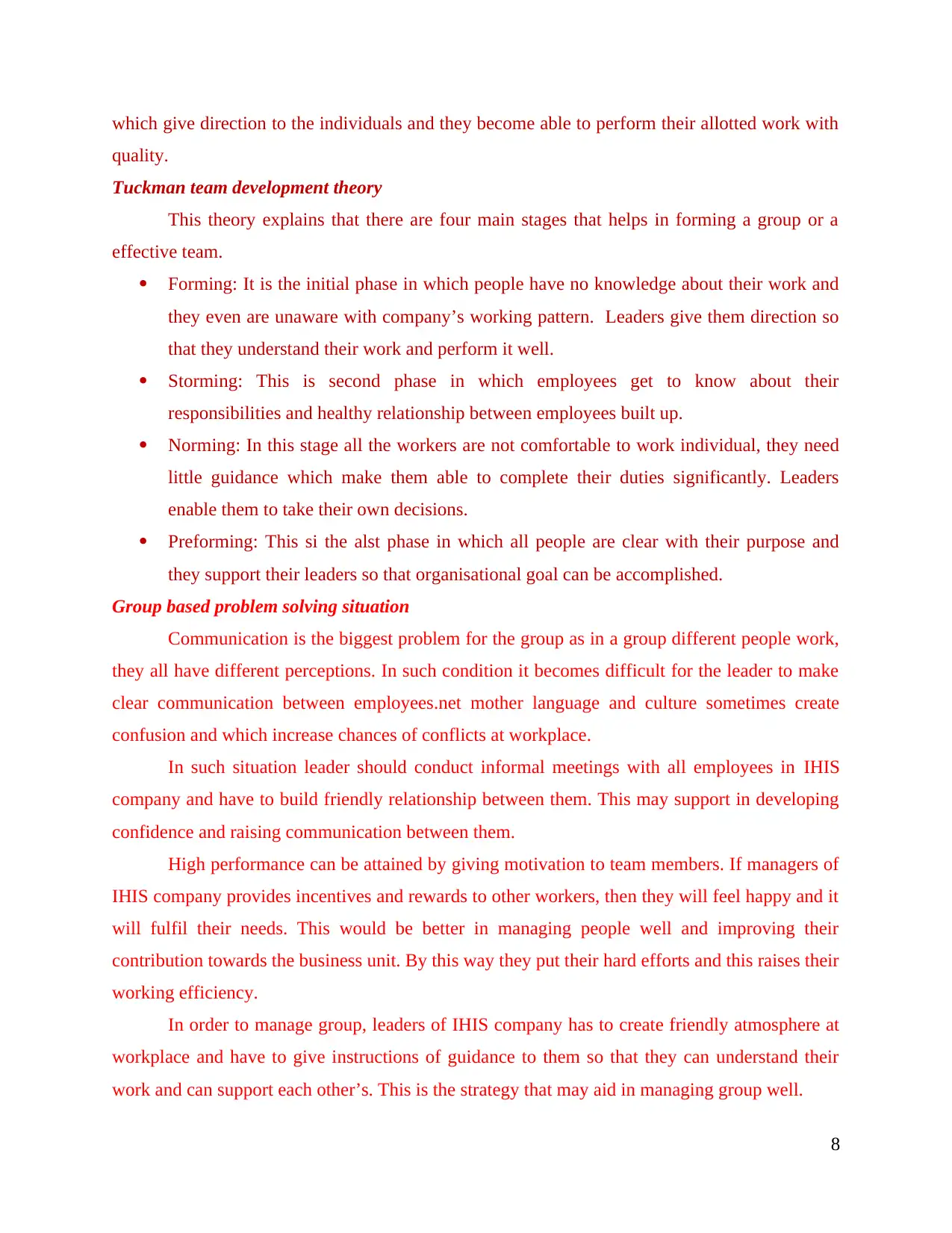
which give direction to the individuals and they become able to perform their allotted work with
quality.
Tuckman team development theory
This theory explains that there are four main stages that helps in forming a group or a
effective team.
Forming: It is the initial phase in which people have no knowledge about their work and
they even are unaware with company’s working pattern. Leaders give them direction so
that they understand their work and perform it well.
Storming: This is second phase in which employees get to know about their
responsibilities and healthy relationship between employees built up.
Norming: In this stage all the workers are not comfortable to work individual, they need
little guidance which make them able to complete their duties significantly. Leaders
enable them to take their own decisions.
Preforming: This si the alst phase in which all people are clear with their purpose and
they support their leaders so that organisational goal can be accomplished.
Group based problem solving situation
Communication is the biggest problem for the group as in a group different people work,
they all have different perceptions. In such condition it becomes difficult for the leader to make
clear communication between employees.net mother language and culture sometimes create
confusion and which increase chances of conflicts at workplace.
In such situation leader should conduct informal meetings with all employees in IHIS
company and have to build friendly relationship between them. This may support in developing
confidence and raising communication between them.
High performance can be attained by giving motivation to team members. If managers of
IHIS company provides incentives and rewards to other workers, then they will feel happy and it
will fulfil their needs. This would be better in managing people well and improving their
contribution towards the business unit. By this way they put their hard efforts and this raises their
working efficiency.
In order to manage group, leaders of IHIS company has to create friendly atmosphere at
workplace and have to give instructions of guidance to them so that they can understand their
work and can support each other’s. This is the strategy that may aid in managing group well.
8
quality.
Tuckman team development theory
This theory explains that there are four main stages that helps in forming a group or a
effective team.
Forming: It is the initial phase in which people have no knowledge about their work and
they even are unaware with company’s working pattern. Leaders give them direction so
that they understand their work and perform it well.
Storming: This is second phase in which employees get to know about their
responsibilities and healthy relationship between employees built up.
Norming: In this stage all the workers are not comfortable to work individual, they need
little guidance which make them able to complete their duties significantly. Leaders
enable them to take their own decisions.
Preforming: This si the alst phase in which all people are clear with their purpose and
they support their leaders so that organisational goal can be accomplished.
Group based problem solving situation
Communication is the biggest problem for the group as in a group different people work,
they all have different perceptions. In such condition it becomes difficult for the leader to make
clear communication between employees.net mother language and culture sometimes create
confusion and which increase chances of conflicts at workplace.
In such situation leader should conduct informal meetings with all employees in IHIS
company and have to build friendly relationship between them. This may support in developing
confidence and raising communication between them.
High performance can be attained by giving motivation to team members. If managers of
IHIS company provides incentives and rewards to other workers, then they will feel happy and it
will fulfil their needs. This would be better in managing people well and improving their
contribution towards the business unit. By this way they put their hard efforts and this raises their
working efficiency.
In order to manage group, leaders of IHIS company has to create friendly atmosphere at
workplace and have to give instructions of guidance to them so that they can understand their
work and can support each other’s. This is the strategy that may aid in managing group well.
8
Paraphrase This Document
Need a fresh take? Get an instant paraphrase of this document with our AI Paraphraser
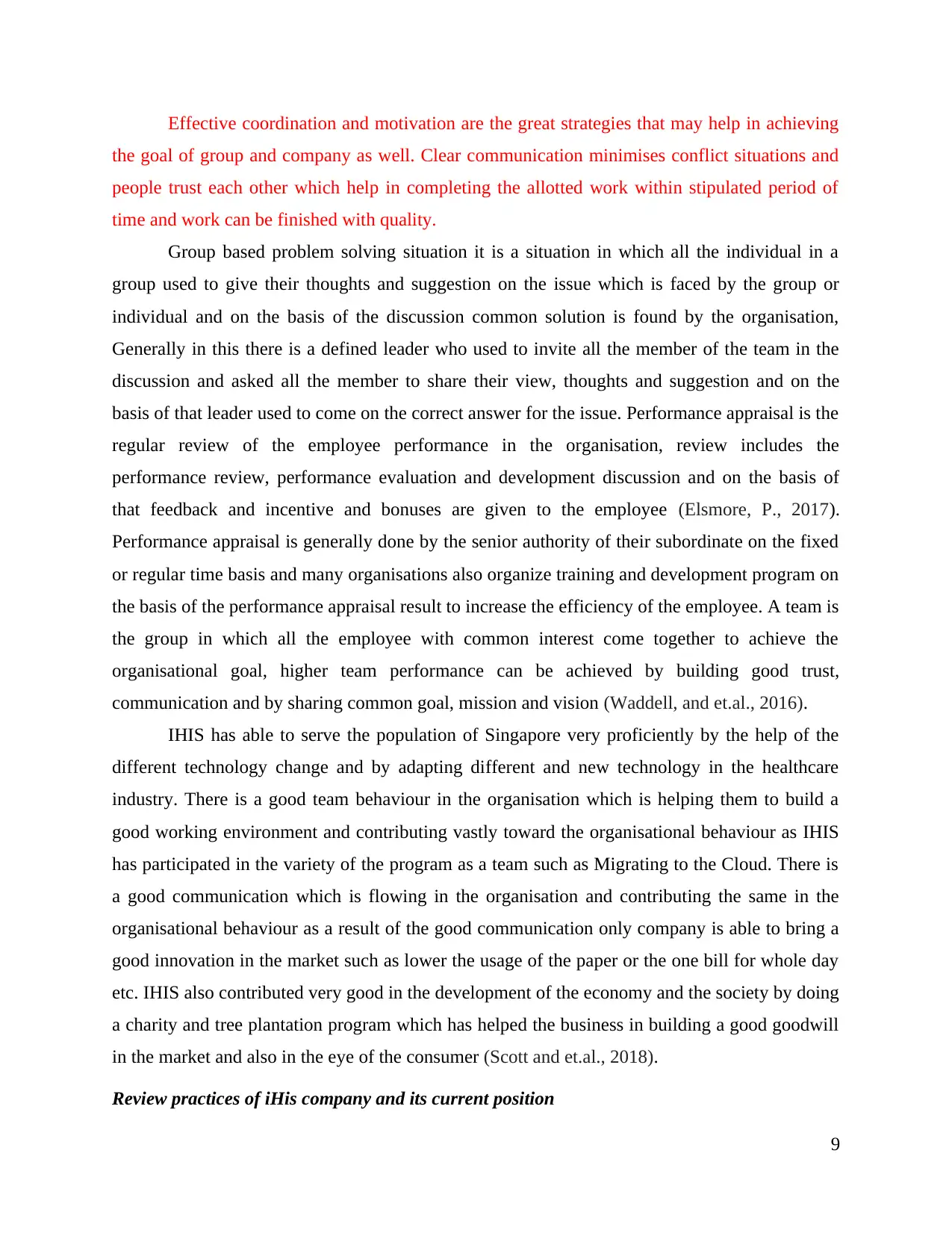
Effective coordination and motivation are the great strategies that may help in achieving
the goal of group and company as well. Clear communication minimises conflict situations and
people trust each other which help in completing the allotted work within stipulated period of
time and work can be finished with quality.
Group based problem solving situation it is a situation in which all the individual in a
group used to give their thoughts and suggestion on the issue which is faced by the group or
individual and on the basis of the discussion common solution is found by the organisation,
Generally in this there is a defined leader who used to invite all the member of the team in the
discussion and asked all the member to share their view, thoughts and suggestion and on the
basis of that leader used to come on the correct answer for the issue. Performance appraisal is the
regular review of the employee performance in the organisation, review includes the
performance review, performance evaluation and development discussion and on the basis of
that feedback and incentive and bonuses are given to the employee (Elsmore, P., 2017).
Performance appraisal is generally done by the senior authority of their subordinate on the fixed
or regular time basis and many organisations also organize training and development program on
the basis of the performance appraisal result to increase the efficiency of the employee. A team is
the group in which all the employee with common interest come together to achieve the
organisational goal, higher team performance can be achieved by building good trust,
communication and by sharing common goal, mission and vision (Waddell, and et.al., 2016).
IHIS has able to serve the population of Singapore very proficiently by the help of the
different technology change and by adapting different and new technology in the healthcare
industry. There is a good team behaviour in the organisation which is helping them to build a
good working environment and contributing vastly toward the organisational behaviour as IHIS
has participated in the variety of the program as a team such as Migrating to the Cloud. There is
a good communication which is flowing in the organisation and contributing the same in the
organisational behaviour as a result of the good communication only company is able to bring a
good innovation in the market such as lower the usage of the paper or the one bill for whole day
etc. IHIS also contributed very good in the development of the economy and the society by doing
a charity and tree plantation program which has helped the business in building a good goodwill
in the market and also in the eye of the consumer (Scott and et.al., 2018).
Review practices of iHis company and its current position
9
the goal of group and company as well. Clear communication minimises conflict situations and
people trust each other which help in completing the allotted work within stipulated period of
time and work can be finished with quality.
Group based problem solving situation it is a situation in which all the individual in a
group used to give their thoughts and suggestion on the issue which is faced by the group or
individual and on the basis of the discussion common solution is found by the organisation,
Generally in this there is a defined leader who used to invite all the member of the team in the
discussion and asked all the member to share their view, thoughts and suggestion and on the
basis of that leader used to come on the correct answer for the issue. Performance appraisal is the
regular review of the employee performance in the organisation, review includes the
performance review, performance evaluation and development discussion and on the basis of
that feedback and incentive and bonuses are given to the employee (Elsmore, P., 2017).
Performance appraisal is generally done by the senior authority of their subordinate on the fixed
or regular time basis and many organisations also organize training and development program on
the basis of the performance appraisal result to increase the efficiency of the employee. A team is
the group in which all the employee with common interest come together to achieve the
organisational goal, higher team performance can be achieved by building good trust,
communication and by sharing common goal, mission and vision (Waddell, and et.al., 2016).
IHIS has able to serve the population of Singapore very proficiently by the help of the
different technology change and by adapting different and new technology in the healthcare
industry. There is a good team behaviour in the organisation which is helping them to build a
good working environment and contributing vastly toward the organisational behaviour as IHIS
has participated in the variety of the program as a team such as Migrating to the Cloud. There is
a good communication which is flowing in the organisation and contributing the same in the
organisational behaviour as a result of the good communication only company is able to bring a
good innovation in the market such as lower the usage of the paper or the one bill for whole day
etc. IHIS also contributed very good in the development of the economy and the society by doing
a charity and tree plantation program which has helped the business in building a good goodwill
in the market and also in the eye of the consumer (Scott and et.al., 2018).
Review practices of iHis company and its current position
9
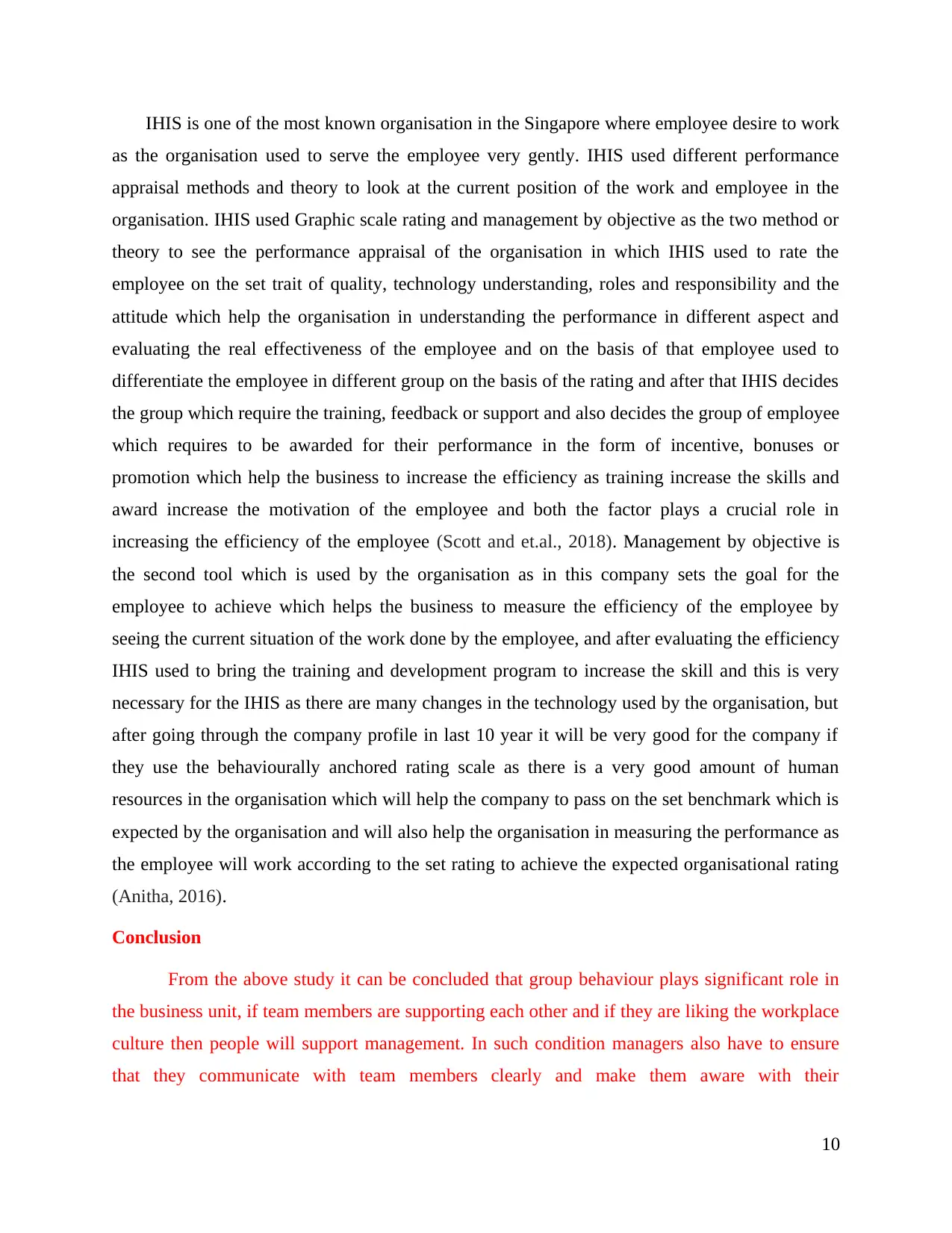
IHIS is one of the most known organisation in the Singapore where employee desire to work
as the organisation used to serve the employee very gently. IHIS used different performance
appraisal methods and theory to look at the current position of the work and employee in the
organisation. IHIS used Graphic scale rating and management by objective as the two method or
theory to see the performance appraisal of the organisation in which IHIS used to rate the
employee on the set trait of quality, technology understanding, roles and responsibility and the
attitude which help the organisation in understanding the performance in different aspect and
evaluating the real effectiveness of the employee and on the basis of that employee used to
differentiate the employee in different group on the basis of the rating and after that IHIS decides
the group which require the training, feedback or support and also decides the group of employee
which requires to be awarded for their performance in the form of incentive, bonuses or
promotion which help the business to increase the efficiency as training increase the skills and
award increase the motivation of the employee and both the factor plays a crucial role in
increasing the efficiency of the employee (Scott and et.al., 2018). Management by objective is
the second tool which is used by the organisation as in this company sets the goal for the
employee to achieve which helps the business to measure the efficiency of the employee by
seeing the current situation of the work done by the employee, and after evaluating the efficiency
IHIS used to bring the training and development program to increase the skill and this is very
necessary for the IHIS as there are many changes in the technology used by the organisation, but
after going through the company profile in last 10 year it will be very good for the company if
they use the behaviourally anchored rating scale as there is a very good amount of human
resources in the organisation which will help the company to pass on the set benchmark which is
expected by the organisation and will also help the organisation in measuring the performance as
the employee will work according to the set rating to achieve the expected organisational rating
(Anitha, 2016).
Conclusion
From the above study it can be concluded that group behaviour plays significant role in
the business unit, if team members are supporting each other and if they are liking the workplace
culture then people will support management. In such condition managers also have to ensure
that they communicate with team members clearly and make them aware with their
10
as the organisation used to serve the employee very gently. IHIS used different performance
appraisal methods and theory to look at the current position of the work and employee in the
organisation. IHIS used Graphic scale rating and management by objective as the two method or
theory to see the performance appraisal of the organisation in which IHIS used to rate the
employee on the set trait of quality, technology understanding, roles and responsibility and the
attitude which help the organisation in understanding the performance in different aspect and
evaluating the real effectiveness of the employee and on the basis of that employee used to
differentiate the employee in different group on the basis of the rating and after that IHIS decides
the group which require the training, feedback or support and also decides the group of employee
which requires to be awarded for their performance in the form of incentive, bonuses or
promotion which help the business to increase the efficiency as training increase the skills and
award increase the motivation of the employee and both the factor plays a crucial role in
increasing the efficiency of the employee (Scott and et.al., 2018). Management by objective is
the second tool which is used by the organisation as in this company sets the goal for the
employee to achieve which helps the business to measure the efficiency of the employee by
seeing the current situation of the work done by the employee, and after evaluating the efficiency
IHIS used to bring the training and development program to increase the skill and this is very
necessary for the IHIS as there are many changes in the technology used by the organisation, but
after going through the company profile in last 10 year it will be very good for the company if
they use the behaviourally anchored rating scale as there is a very good amount of human
resources in the organisation which will help the company to pass on the set benchmark which is
expected by the organisation and will also help the organisation in measuring the performance as
the employee will work according to the set rating to achieve the expected organisational rating
(Anitha, 2016).
Conclusion
From the above study it can be concluded that group behaviour plays significant role in
the business unit, if team members are supporting each other and if they are liking the workplace
culture then people will support management. In such condition managers also have to ensure
that they communicate with team members clearly and make them aware with their
10
⊘ This is a preview!⊘
Do you want full access?
Subscribe today to unlock all pages.

Trusted by 1+ million students worldwide
1 out of 23
Related Documents
Your All-in-One AI-Powered Toolkit for Academic Success.
+13062052269
info@desklib.com
Available 24*7 on WhatsApp / Email
![[object Object]](/_next/static/media/star-bottom.7253800d.svg)
Unlock your academic potential
Copyright © 2020–2025 A2Z Services. All Rights Reserved. Developed and managed by ZUCOL.





